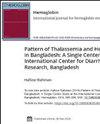巴西的镰状细胞病:目前的管理。
IF 1.2
4区 医学
Q4 BIOCHEMISTRY & MOLECULAR BIOLOGY
引用次数: 0
摘要
镰状细胞病(SCD)是由β-球蛋白基因突变(c20A > T,pGlu6Val)引起的遗传性红细胞疾病,其特征是出现异常血红蛋白、血红蛋白S、溶血和血管闭塞。这种突变,无论是在同型配置中还是在与其他β-球蛋白突变的复合状态中,都会导致血红蛋白S在脱氧条件下发生聚合,从而引起红细胞形状的改变,尤其是镰状红细胞。血管闭塞性危象(VOC)是该病的特征,但反复发作的 VOC 也可能导致其他严重并发症。SCD 被认为是一个全球性的健康问题,其发病率在世界某些地区有所上升,尤其是在美洲和非洲。主要由于当地资源和社会经济状况的不同,世界各地对该疾病的管理也不尽相同。本综述旨在描述有关 SCD 可用治疗方案的最新数据,尤其是在巴西。预计所有患者都能获得新的治疗方案,尤其是已在巴西获得批准的克昔单抗(crizanlizumab)。本文章由计算机程序翻译,如有差异,请以英文原文为准。
Sickle Cell Disease in Brazil: Current Management.
Sickle cell disease (SCD) comprises inherited red blood cell disorders due to a mutation in the β-globin gene (c20A > T, pGlu6Val) and is characterized by the presence of abnormal hemoglobin, hemoglobin S, hemolysis, and vaso-occlusion. This mutation, either in a homozygous configuration or in compound states with other β-globin mutations, leads to polymerization of hemoglobin S in deoxygenated conditions, causing modifications in red blood cell shape, particularly sickling. Vaso-occlusive crisis (VOC) is the hallmark of the disease, but other severe complications may arise from repeated bouts of VOCs. SCD is considered a global health problem, and its incidence has increased in some areas of the world, particularly the Americas and Africa. Management of the disease varies according to the region of the world, mainly due to local resources and socioeconomic status. This review aimed to describe more recent data on SCD regarding available treatment options, especially in Brazil. New treatment options are expected to be available to all patients, particularly crizanlizumab, which is already approved in the country.
求助全文
通过发布文献求助,成功后即可免费获取论文全文。
去求助
来源期刊

Hemoglobin
医学-生化与分子生物学
CiteScore
1.70
自引率
10.00%
发文量
59
审稿时长
3 months
期刊介绍:
Hemoglobin is a journal in the English language for the communication of research and information concerning hemoglobin in humans and other species. Hemoglobin publishes articles, reviews, points of view
The journal covers topics such as:
structure, function, genetics and evolution of hemoglobins
biochemical and biophysical properties of hemoglobin molecules
characterization of hemoglobin disorders (variants and thalassemias),
consequences and treatment of hemoglobin disorders
epidemiology and prevention of hemoglobin disorders (neo-natal and adult screening)
modulating factors
methodology used for diagnosis of hemoglobin disorders
 求助内容:
求助内容: 应助结果提醒方式:
应助结果提醒方式:


